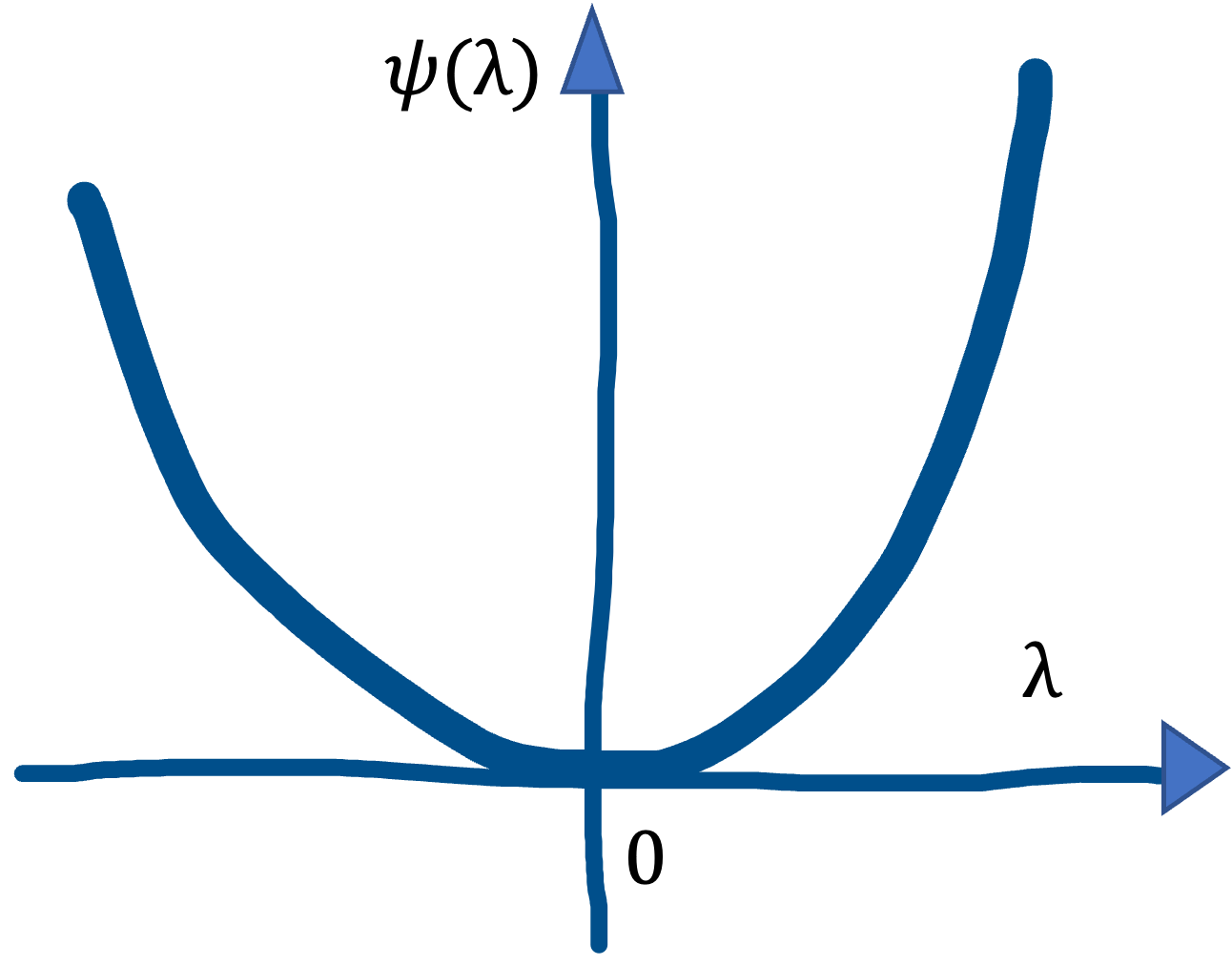The first and second derivertive of log moment generating function for $Z$, $\psi(\lambda)$, can be expressed with exponential tilting by $ \frac {e^{\lambda Z}} {\mathop{\mathbb{E}} \left \lbrack e^{\lambda Z} \right \rbrack } $ introduced in this post, and from this the convexity of $\psi(\lambda)$ is shown. Using the fact we see in this post, Hoeffding’s inequality is immediately derived, as we will see in the later post.
As before,
$\psi(\lambda)$ denotes
$
\log \mathbb{E} e^{ \lambda (Z - \mathbb{E} Z )}
$
and by exponential tilting,
the original measure $P$ is tilted into
$
Q = P_{
\frac
{e^{\lambda Z}}
{\mathbb{E} \left \lbrack e^{\lambda Z} \right \rbrack }
}.
$
Then, we have
\[
\psi’(\lambda) = \mathbb{E}_{Q} \left \lbrack Z - \mathbb{E}Z \right \rbrack,
\]
\[
\psi’'(\lambda) = \text{Var}_{Q} \left \lbrack Z \right \rbrack,
\]
and
\[
\psi(\lambda) = \psi’’(\lambda) = 0,
\ \
\psi’'(0) = \text{Var} \left \lbrack Z \right \rbrack,
\]
where
$\mathbb{E}$ and $\text{Var}$ is the moment over $P$ as
$\mathbb{E} = \mathbb{E}_{P}$ and $\text{Var} = \text{Var}_{P}$.
First derivertive
As $ \psi(\lambda) = \log \mathbb{E} e^{ \lambda Z } - \log \mathbb{E} e^{ \lambda \mathbb{E} Z } = \log \mathbb{E} e^{ \lambda Z } - \lambda \mathbb{E} Z$, we know \[ \psi(0) = 0. \] The well known property of $\psi(\lambda)$ is that it is differentiable any number of times. The first derivertive is \[ \psi’(\lambda) = \frac { \mathbb{E} \left \lbrack Z e^{\lambda Z} \right \rbrack } { \mathbb{E} \left \lbrack e^{\lambda Z} \right \rbrack } - \mathbb{E} Z = \mathbb{E}_{Q} Z - \mathbb{E} Z = \mathbb{E}_{Q} \left \lbrack Z - \mathbb{E} Z \right \rbrack. \] From the fact that $Q = P$ when $\lambda = 0$, we know \[ \psi’(0) = 0. \]
Second derivertive
Next, since $\mathbb{E} Z$ is constant w.r.t. $\lambda$, we have \[ \psi’'(\lambda) = \frac{d}{d \lambda} \left ( \frac { \mathbb{E} \left \lbrack Z e^{\lambda Z} \right \rbrack } { \mathbb{E} \left \lbrack e^{\lambda Z} \right \rbrack } \right ). \] As $ \left ( \frac{f}{g} \right ) = \frac{1}{g^{2}} \left ( f’g - fg’ \right ) $, the above is \[ = \frac{1}{ \left ( \mathbb{E} \left \lbrack e^{\lambda Z} \right \rbrack \right )^{2}} \left ( \frac{d}{d \lambda} \left ( \mathbb{E} \left \lbrack Z e^{\lambda Z} \right \rbrack \right ) \mathbb{E} \left \lbrack e^{\lambda Z} \right \rbrack - \mathbb{E} \left \lbrack Z e^{\lambda Z} \right \rbrack \frac{d}{d \lambda} \left ( \mathbb{E} \left \lbrack e^{\lambda Z} \right \rbrack \right ) \right ) \] \[ = \frac{1}{ \left ( \mathbb{E} \left \lbrack e^{\lambda Z} \right \rbrack \right )^{2}} \left ( \mathbb{E} \left \lbrack Z^{2} e^{\lambda Z} \right \rbrack \mathbb{E} \left \lbrack e^{\lambda Z} \right \rbrack - \mathbb{E} \left \lbrack Z e^{\lambda Z} \right \rbrack \mathbb{E} \left \lbrack Z e^{\lambda Z} \right \rbrack \right ). \] By transforming the measure from $P$ to $Q$, the above is \[ =\mathbb{E}_{Q} Z^{2} - \left ( \mathbb{E}_{Q} Z \right )^{2} = \text{Var}_{Q} \left \lbrack Z \right \rbrack \geq 0. \] As the second derivatibe is grater than $0$, it shows that $\psi(\lambda)$ is convex.

Lastly, from the fact that $Q = P$ when $\lambda = 0$, we know \[ \psi’'(0) = \text{Var}(Z). \]